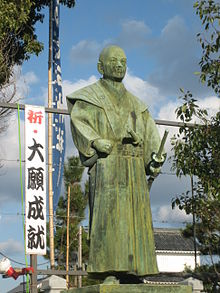- Ōishi Yoshio
-
Ōishi Yoshio (大石 良雄, 1659 – March 20, 1703) was the chamberlain (karō) of the Akō Domain in Harima Province (now Hyōgo Prefecture), Japan (1679 - 1701). He is known as the leader of the Forty-seven Ronin in their 1702 vendetta and thus the hero of the Chūshingura. He is often referred to by his title, Ōishi Kuranosuke (大石内蔵助).
He served Asano Naganori as the head chamberlain (hittōgarō (筆頭家老)) for the Asano estate, supervising the daily running of the castle and the samurai. Due to the Tokugawa rules which required all the daimyos to spend every other year in Edo (now called Tokyo) the chamberlain was a very important man and the defacto ruler of the estate when the daimyo was away. Having attained this office at a rather young age, he is said to have had the implicit trust of his lord.
When Asano committed seppuku as punishment for his failed attempt to kill Kira Yoshinaka in Edo castle and the Tokugawa shogunate abolished the house of Asano in Akō, Ōishi was in Akō and managed all its administrative issues. He persuaded other samurai to vacate the castle to the agents of the Shogunate. During the next two years many people wondered what Oishi would do as he had a reputation as an honorable and capable man.
He attempted to get the permission to re-establish the house of Asano but failed. He then began a careful plot to kill Lord Kira but to throw off suspicion spent time (and money) in the Geisha houses of Kyoto. This type of ruse is referred to as hiru andon (昼行灯 daylight lantern) – appearing to be serving no useful purposes, and this term is frequently applied to Ōishi. He carried out his role well – and secretly coordinated the movements of the remaining loyal Asano samurai. Nearly two years passed before the attack was launched.
In January 1703 (by the old Japanese calendar, December 14) he, with 46 other Akō ronin, attacked Kira at his residence in the Honjo neighborhood of Edo. Kira was killed and decapitated. After Ōishi dispatched Terasaka Kichiemon to inform Asano's widow Yōzeiin of the deed, he and the remaining 45 ronin went to Sengaku-ji in Shinagawa where Naganori was buried and there they were arrested.
He and the other ronin were sentenced to commit seppuku. Since it was an honorable sentence rather than merely decapitation, everyone accepted this sentence as an honor.
In the famous kabuki play Kanadehon Chūshingura, Yoshio (Kuranosuke) is known as Ōboshi Yuranosuke.
After death, Oishi became famous as the example of ideal samurai behavior. His ultimate goal of reestablishment of the Asano clan was realized as the Tokugawa shogunate did restore some lands (about 1/10 of the original holdings) to the Asano clan.
Oishi was in fact related to the Asano clan by blood, as several generations prior, an Oishi man married a daughter of the Asano.
Wikimedia Foundation. 2010.




